After an afternoon filled with information about organic agriculture in Hamilton County, the Farm Crawl participants were treated to a farm to table buffet dinner with many foods that came from some of the farms on the tour.

City Scene pg. 12
The Daily Freeman-Journal August 2023
OUR HAMILTON COUNTY hometown









2 OUR HOMETOWN | AUGUST 2023 The Prescription is Planning Are you approaching retirement with concerns about Medicare? First State Bank Investment Services invites you to attend a complimentary seminar Healthcare in Retirement Thursday, September 7, 2023 6:30 pm - 7:30 pm First State Bank | 505 2nd St | Webster City, IA 50595 (Use West Entrance to 2nd Floor Conference Room) Guest Speaker: James Schomburg - Senior Retirement Consultant; Pacific Life Hosted By: Will Johnston, Financial Advisor; First State Bank Investment Services** Dessert will be served Three questions we'll consider 1. When to enroll in Medicare? 2. What are my enrollment options? 3. How much is this going to cost? Please RSVP by Wednesday, September 6, 2023 to Candy Butz, Administrative Assistant | (515) 832-2520 | or email to johnstonw@ceteranetworks.com **Securities and advisory services offered through Cetera Advisor Networks LLC, member FINRA/SIPC, a Broker-Dealer and a Registered Investment Advisor Investments are *Not FDIC insured *May lose value *Not financial institution guaranteed *Not a deposit *Not Insured by any federal government agency Cetera is under separate ownership from any other named entity



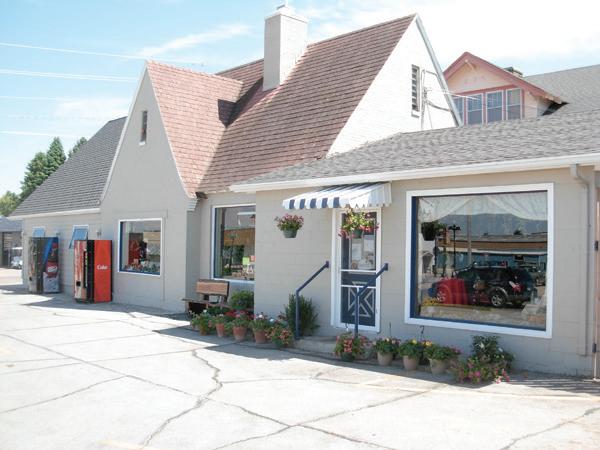
AUGUST 2023 | OUR HOMETOWN 3 V.9 ISSUE 10 | AUGUST 2023 EVERY ISSUE : 12 City Scene 14 Let’s Eat 16 Landmarks 18 Savvy Senior 23 Parting Shot CONTRIBUTORS EDITOR JANE CURTIS PUBLISHER TERRY CHRISTENSEN ADVERTISING TREVOR CHRISTENSEN GRAPHIC DESIGN MICHELLE COLSHAN STORY & PHOTOS DAVID BORER hometown OUR Direct inquiries to: 720 Second Street, Webster City, Iowa 50595 515-832-4350 Our Hometown is published monthly by The Daily Freeman-Journal, with all rights reserved, Copyright, 2023. PUBLICATION INFORMATION FLOWER CART “Your Complete Florist” www.flocart.net 800 Second Street • Webster City, IA 1-800-286-4630 832-4630
An enthusiastic group of Farm Crawl participants have boarded the air conditioned motor coach as they are ready to head off to Knob Hill Farm, which is owned by Mike and Janine Robertson.
Those on the Farm Crawl were unable to go onto the grounds of Knob Hill Farm due to biosecurity security measures to prevent disease amongst their organically raised pigs and chickens. However, the tour bus did pull up beside this picturesque farm.

Farm Crawl
In a first, Hamilton County producers welcome a busload to their organic ways
 By DAVID BORER
By DAVID BORER
It’s not every day that you come across a farming operation that uses draft horses to pull plows and planters, but that is what a busload of people attending the Iowa Organic Association’s Hamilton County Farm Crawl learned Sunday, August 6, from Mike and Janine Robertson, owners of Knob Hill Farm located in rural Webster City.
When much-needed rain fell on the fields of Hamilton County, 60 people rode through the countryside in the comfort of an air-conditioned motor coach to learn more about organic farming at five operations that have embraced this method of producing products from wine and beer to meat, vegetables, feed, hemp and cheeses. And that’s just some of the items produced without the use of chemicals.
The Farm Crawl converged on Backcountry Winery and Brewery, owned by Preston and Amber Gable. It is located east of Stratford at 3533 Fenton Ave.
Amber Gable told the attendees about the operation and then led the group to where the grapes are processed into wine. The varietals of grapes they grow are Frontenac gris, Frontenac blanc and Brianna, she said.

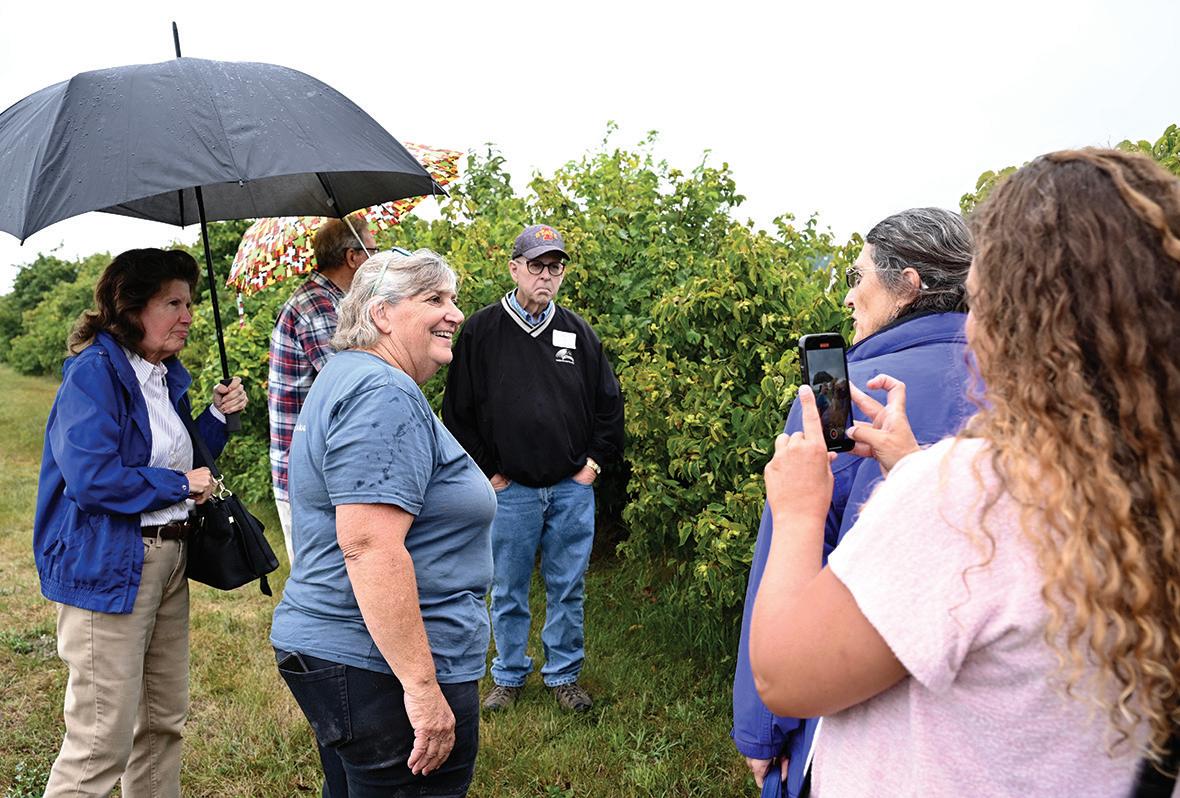
In addition to making wine, Backcountry hosts a wide range of activities, from live music to trivia nights and class reunions. And, of course, weddings.
Back on the bus, the Farm Crawl headed to Blue Stem Organic Feed Mill, 1565 280th St., rural Webster City. Cindy McCollough, who lit the flame for the Farm Crawl, is the owner of this operation.
6 OUR HOMETOWN | AUGUST 2023
Blue Stem Organic Feed Mill owner, Cindy McCollough, takes questions from participants of the Farm Crawl while showing them her hazelnut orchard. The hazelnut trees serve as a buffer zone for her organic feed mill operation.
At Bluestem Prairie Organic Hemp, owned by Bridget Chambers and her husband Bryan Gilbert, Chambers shows the Farm Crawl members the hemp’s appearance after it has been dried and stripped off the plant.
Blue Stem’s organic feed is produced with certified organic ingredients, meaning no antibiotics, hormones or animal byproducts. For a product to be considered a certified organic product, it must be inspected by a third-party agency that ensures that no harmful chemicals or prohibited substances have been applied to a field for at least three years, she explained. In addition, the operation must document that it follows strict standards to qualify for certification. Detailed records of their practice are required.
Ecologically friendly methods and substances have been used to improve the soil and to control pests, she said.
Blue Stem is USDA — United States Department of Agriculture — approved through the National Organic Program.
While at Blue Stem, Mike and Janine Robertson, of Knob Hill Farm, spoke about their organic farm. The Robertsons use draft horses to pull their farm equipment.
Mike Robertson explained what goes into producing organic products and what needs to be taken into account. For instance, the Robertsons are required to have a buffer from surrounding farms so that chemicals don’t drift over to their fields.
Lin Sorenson, of Webster City, said, “As a conservation farmer, I really admire the tremendous work these organic farmers are doing. It takes a lot more energy
to do this type of farming, but it’s so good for the environment and it truly is sustainable.”
Knob Hill Farm is 10 acres, with four of them reserved for growing hay to feed the pigs and horses. The pigs are organic, however the pork cannot be labeled as organic due to the meat locker they use not being certified organic, the Robertsons explained. They also offer certified organic eggs and vegetables, as well as a handful of other products. “I have purchased meat from Knob Hill Farm and I’ve met Mike and Janine, but it was really interesting for me to hear what all they had, because I wasn’t aware of how many different things they had and I was not aware that they used draft horses,” Bridget Chambers, of Webster City, said. “That was so cool to see.”
From Blue Stem Organic Feed, the Farm Crawl proceeded to Bluestem Prairie Farm where Chambers and Bryan Gilbert, its owners, grow organic, non-GMO hemp.
Located at 2522 Tunnel Mill Road in rural Webster City, Bluestem Prairie’s hemp is USDA-Certified Organic. According to Chambers, they get their hemp seeds from Oregon and, after the harvest, they take the hemp back to Oregon by U-Haul to be processed. No pesticides or herbicides are used on their hemp. They use organic fertilizers that are applied to their fields via an underground irrigation system, she said.
From the hemp, Bluestem Prairie Farm produces six

AUGUST 2023 | OUR HOMETOWN 7
Tending the herd of cows is Kevin Dietzel, owner with his wife Ranae Dietzel of Lost Lake Farm. Among the breeds the Dietzels raise are Brown Swiss, Jersey-Holstein crosses, Normande crosses, and New Zealand Frisians.
While stopping at one of the pastures of

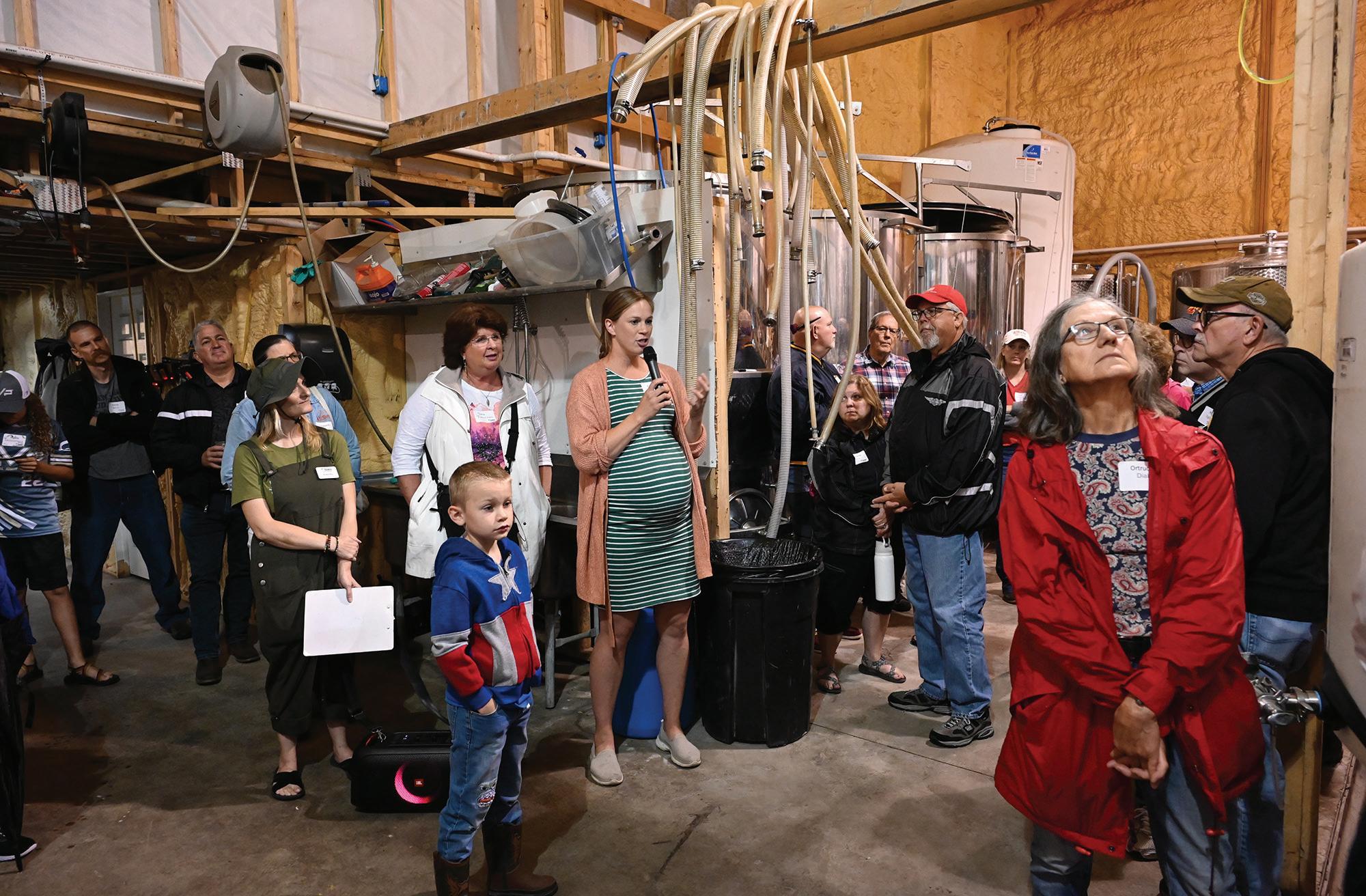

8 OUR HOMETOWN | AUGUST 2023
On Sunday, August 6, 2023, Amber Gable, co-owner of Backcountry Winery and Brewery of rural Stratford along with her husband Preston Gable, tells attendees of the Hamilton County Farm Crawl about their process of making wine.
Cindy McCollough, owner of Blue Stem Organic Feed Mill, located in rural Webster City, answers questions about her organic feed operation during the Hamilton County Farm Crawl.
Lost Lake Farm, Kevin Dietzel talks about the different types of grasses that their cows graze on. Kevin owns the farm along with his wife Ranae Dietzel. They use the milk from their cows to make 12 varieties of cheeses.
products: Certified Organic Full Spectrum CBDa + CBD Oil in two strengths; a 1500 mg orange-flavored drops and a 2300 mg natural-flavored option; Certified Organic Full-Spectrum Sports Balm; Certified Organic Full-Spectrum Scented Body Oil; Soft Gels; and CBD Gummies.
At Lost Lake Farm, the last stop before heading back to Backcountry Winery, owners Kevin and Ranae Dietzel take care of 20 grass-fed cows that they milk. From that milk, they produce 12 types of cheeses.
At Lost Lake, which is just north of Jewell, samples of three of their cheeses were available for tasting.
The cows that produce the milk range from Brown Swiss, Jersey-Holstein crosses, and Normande crosses to New Zealand Frisians.
The beautiful cows were a big hit with those on the tour.
Due to the steady rain, the Dietzels gave their presentation on the motor coach. They said that 200 pounds of cheese is made per week. Sales are mostly made at farmers markets and online.
The meal that awaited the group’s return to Backcountry was farm to table, largely consisting of the products from the farms they visited.

“Every place we went had something interesting, but probably my favorite was learning about the cheeses and all of the products of Lost Lake Farm,” said Sue Doolittle, of Webster City.
One of the participants, Mikaela Seely, came because she has worked on organic farms, which followed her college years when she focused on sustainability and ecology.
“I really enjoyed just the experience to see all the different types of farms that are in this area. I’m from Cedar Rapids, so we don’t have a hemp farm near us, or a such a variety in such a close vicinity.”
This was the first Hamilton County Farm Crawl and it left the host farms proud.
Amber Gable, of Backcountry, said, “I think it was a really unique experience. We don’t often open our backroom for visitors on the average weekend. So showing the behind the scenes and the production was really neat to be able to share. One of my passions in is connecting people to their food, showing where this comes from and seeing the whole experience start to finish. So that was exciting to be able to offer that.”
Rosalyn Lehman, who works with the Iowa Organic Association that helped organize the Farm Crawl, said, “I think it was a smashing success. We had a sold-out bus. That is a true testament of how interested people were to connecting with the local products. I feel like a lot of the people on the bus were from the community, so it was a great chance for them to meet the farmers
AUGUST 2023 | OUR HOMETOWN 9
Back at Backcountry Winery & Brewery, attendees of the Farm Crawl had the opportunity to purchase products from the organic farms that hosted those on the tour.
of the products they might have been enjoying over the past few years.”
Education is the key, they all said. There still are many people who are unaware or lack knowledge about organic farming.
Erika Otto, the Education and Outreach coordinator for Iowa Organic Association, said that it is looking to do more Farm Crawl events to spread the word about organic farming.
“Another part of my job is outreach, so going to various field days and meeting the farmers and just
 The vineyard at Backcountry Winery & Brewery at the conclusion of the Hamilton County Farm Crawl.
The vineyard at Backcountry Winery & Brewery at the conclusion of the Hamilton County Farm Crawl.
connecting that community and seeing how we can work with different partners, different events that we might be able to do, I’m really excited about the plethora of opportunities that could present themselves,” she said.
Iowa is a major player in organic farming, being the No. 1 producer of organic corn, organic soybeans, organic oats and organic hogs, she said. Iowa is the sixth largest organic producer in the U.S. with nearly 800 organic operations in Iowa alone on 170,000 acres.
With continued awareness, the future looks bright for organic farmers, she said.

CITY SCENE CITY SCENE
Investing in Webster City’s Future While Remaining Compliant with Iowa DNR
The City has been working towards planning for the construction of a new wastewater treatment plant for several years now. There are three main issues driving the need to construct a new wastewater treatment plant:
1. The Iowa Department of Natural Resources (DNR) regulations and Nutrient Reduction Strategy.
2. The age/design of the City’s current wastewater treatment plant and limited capacity.
3. The floodplain surrounding the existing wastewater treatment plant.
Webster City, like many other Iowa communities faces the challenge of meeting the DNR’s Nutrient Reduction Strategy. According to the DNR’s factsheet, the strategy is part of the EPA requirement and framework “which calls for the 12 states along the Mississippi River to craft strategies to reduce nutrients reaching the Gulf of Mexico. In addition to impacting the Gulf, excessive amounts of nutrients can also negatively affect local Iowa streams. Nutrient reduction by wastewater dischargers will protect and improve water quality in those streams, especially during low stream flow periods when point sources have the greatest impact.”
In Iowa the DNR regulates wastewater treatment plants and implements the EPA’s National Pollutant Discharge Elimination System (NPDES) permit program. In 2016, the City’s NPDES permit required the City to perform a nutrient reduction evaluation of the wastewater treatment plant. By 2018, the DNR amended the NPDES permit and required the City to pursue upgrades in order to meet the Nutrient Reduction Strategy requirements. The amendment to the 2016 permit and the subsequent 2021 permit required construction of required improvements be completed by March 2024.
The DNR has several enforcement methods available to them to ensure compliance with permit requirements. Iowa Code §455B.191 specifies that “Any person who violates any provision of this part 1 of subchapter III or any permit, rule, standard, or order issued under this part 1 of subchapter III shall be subject to a civil penalty not to exceed five thousand dollars for each day of such violation.” More severe or chronic violators may face conviction “punishable by a fine of not more than one hundred thousand dollars for each day of violation or by imprisonment for not more than five years, or both.”
Since 2017, the DNR has carried out enforcement actions against 36 cities throughout Iowa. Many of the enforcement actions resulted in fines and strict requirements to complete construction of treatment facility upgrades necessary to comply with the limitations contained in their NPDES permit by a specified date. (https://www.iowadnr.gov/about-dnr/aboutdnr/enforcement-actions)
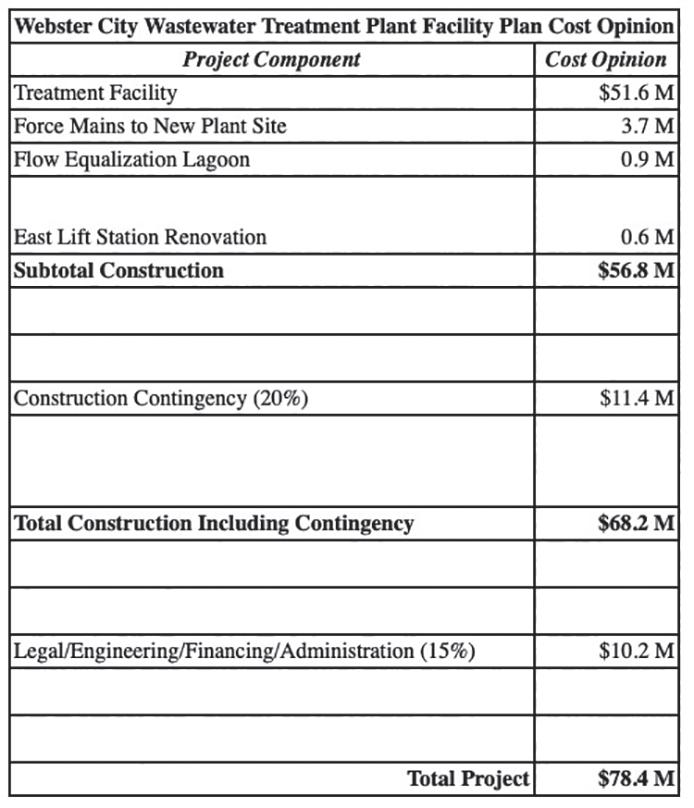
The City of Webster City has worked diligently to remain in compliance with its NPDES permit. In January of 2023 the DNR approved the City’s Facility Plan for its new wastewater treatment plant. The City recently reviewed various alternative recommendations made by a graduate student at Iowa State University. The City also has had a third party review the City’s Facility Plan to proceed with the technology selected for the new Wastewater Treatment Plant and to review the engineer’s estimate. The City will be continuing to proceed with final design of the wastewater treatment plant and other sewer system upgrades.
Average wastewater treatment plant life expectancy in the U.S. is 40 to 50 years, and treatment equipment typically lasts 15 to 20 years. The City’s existing wastewater treatment plant components are on borrowed time. Webster City’s wastewater treatment plant was originally constructed in 1939. The chart shows the construction date and age of critical components of the facility.
12 OUR HOMETOWN | AUGUST 2023
CITY SCENE
Location of the New Wastewater Treatment Plant

The location of the new wastewater treatment plant has been carefully chosen to address potential challenges. The existing plant currently sits within a floodplain, making it susceptible to flooding during heavy rains or natural disasters. Moreover, residential homes surround it, posing safety and health concerns. To mitigate these risks, the city has decided to construct the new plant in an area that is outside the floodplain and away from residential neighborhoods in an industrial area, south of Highway 20.
Constructing a new modern wastewater treatment plant is essential to ensure the compliance with new stringent regulations and replacing our aging wastewater treatment plant. Webster City’s decision to construct a new wastewater treatment plant is an important step towards ensuring a cleaner and safer future for its residents. The aging existing plant, located within a floodplain and near residential areas, poses significant challenges and risks. By relocating the new plant to a safer area outside the floodplain and investing in modern infrastructure, the city is taking measures to address wastewater management effectively.
As the project progresses, Webster City moves closer to achieving its goals of sustainable and responsible wastewater treatment, benefiting both the community and the environment. Through collaboration with experts and strategic planning, Webster City ensures that residents and businesses will enjoy the benefits of an efficient and modern wastewater treatment system, all while preserving the beauty of nearby natural resources such as the Boone River.
Given the age and condition of the wastewater treatment plant’s critical components, the City must make a significant investment in a new wastewater treatment plant. Failure to do so may result in the inability to properly treat the community’s sewage.
The City currently utilizes Rotating Biological Contactor (RBC) biological process technology to treat wastewater. The RBC process, while valuable, has limitations in handling these pollutants effectively. In order to comply with the DNR’s requirement set forth in the plant’s permit, the City will need to shift from the RBC biological process to an Activated Sludge Process. The Nutrient Reduction Strategy assumed that RBC plants would eventually be replaced with activated sludge processes that could handle nitrogen and phosphorus removal. RBC equipment has a design service life of about 20 years, and Webster City’s RBC equipment is at the end of its service life and has begun to experience increase maintenance and repairs of its aging RBC units and equipment.
As part of the efforts to keep the community informed on the project progress and status, the City has a dedicated webpage on the City website for the new Wastewater Treatment Plant project. You may find more information on the project by visiting: https://webstercity.com/government/departments/ public-works/water-treatment-plant/wastewater-treatmentplant-project/.



AUGUST 2023 | OUR HOMETOWN 13
LET’S EAT






Our Hometown Recipe Corner

Turn your grill into a pizza maker
Some say an outdoor kitchen isn’t complete without a pizza oven. A delicious pie straight out of a blazing hot oven can be delectable when dining al fresco, but pizza also can be made right on the grill.

3 Cart sizes available!






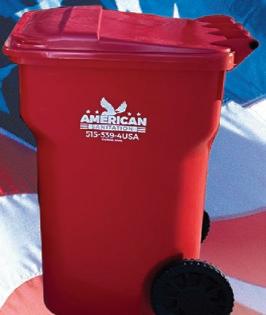



This recipe for “The Chicagoan” from Craig W. Priebe’s “Grilled Pizzas & Piadinas” utilizes grilled beef and sliced potatoes to give this grilled pizza a steakhouse flavor. Use a homemade dough or your favorite premade variety available at your local grocery store.

14 OUR HOMETOWN | AUGUST 2023
Dumpsters & Roll-Offs Multiple Sizes AmericanSanitationLLC.com
The Chicagoan
Makes a 12-inch pizza
1 russet potato, peeled and sliced about 1⁄4-inch thick
3 tablespoons extra virgin olive oil
1 teaspoon salt
1⁄2 teaspoon freshly ground black pepper
8 ounces top sirloin or strip steak
1⁄2 teaspoon salt
Freshly ground black pepper
1 grilled pizza crust
1 tablespoon grated Parmesan
1 cup shredded mozzarella
1⁄2 cup shredded cheddar
1 cup chunky tomato sauce
1⁄2 cup thinly sliced red onions
1⁄4 cup sour cream
2 tablespoons minced fresh chives

Grilling the crust
1. Preheat the oven to 400 F. Place the sliced potato in a large bowl and toss with two tablespoons olive oil, salt and pepper. Line a baking sheet with foil and spread the slices in a single layer. Bake for about 15 minutes, until the potato is golden and tender. While still hot, loosen the slices with a spatula so they don’t stick.
2. Prepare a grill for direct cooking over high heat. Season the steak liberally on both sides with the salt and pepper. Grill the steak over the hottest part of the fire for 4 minutes. Turn and grill for 4 minutes longer, until the steak is medium-rare and well charred. Remove and let sit for 5 minutes. Slice thinly.
3. Brush the grilled side of the pizza crust with the remaining one tablespoon olive oil and dust with the Parmesan. Sprinkle the mozzarella and cheddar on top. Drop spoonfuls of the chunky tomato sauce onto the pizza. Top with the potato, red onion and the steak.
4. Grill the pizza with indirect heat. If your grill is still hot, move coals to one side or turn off one burner and allow the pizza to cook on the side without a direct flame. Grill the pizza for 5 to 8 minutes, or until the crust is crisp and brown. The bottom may have a few black spots from charring. Optional: Broil the cooked pizza in the oven for 1 to 2 minutes more to caramelize the top.
5. Before serving, drop teaspoons of the sour cream onto the pizza, and garnish with the fresh chives.
To grill a pizza crust for this recipe, roll out to a 12-inch circle and place on a cookie sheet. Adjust the grill to reach a temperature of 400 F.

Slide the dough onto the grill. The dough should take about 3 minutes to cook. Watch for bubbles. The crust will be soft at first and tear easily. To check doneness, lift the underside. It should be an even light brown with brown grill marks.
Pick up the crust using tongs and place it on your cookie sheet. Flip it over so the grilled side is face up. This browned side becomes the top of your pizza.
AUGUST 2023 | OUR HOMETOWN 15
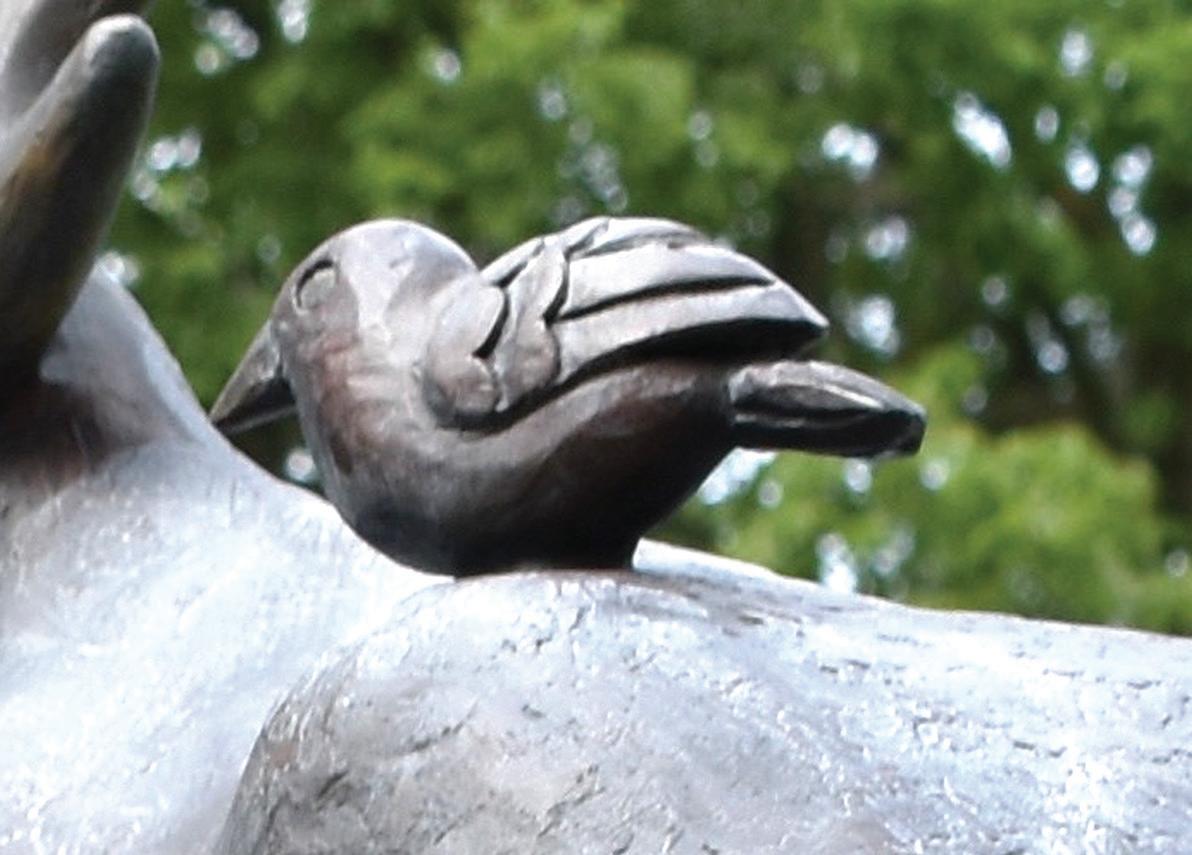
16 OUR HOMETOWN | AUGUST 2023
HowwellDOYOU know Hamilton County? Photo No. 1 Tacqueria La Bomba, 1137 Second Street, Webster City Photo No. 2 American Legion, 726 Second Street, Webster City Elizabeth Korth, Dows July Answers: WINNER-WINNER: Look at these photos and see if you can identify these local landmarks. LANDMARKS
Photo#1

AUGUST 2023 | OUR HOMETOWN 17 Please include the name of the building icon on which the Landmark is located, your name & phone number. Submit your entry tanderson@freemanjournal.net or deliver to The Daily Freeman-Journal at 720 Second St., Webster City, IA
Submit your entry Correct answers will be entered into a drawing for 2FREEMOVIEPASSES to the Webster Theater
Photo#2
SAVVY SENIOR
by Jim Miller
How to Plan a Green Funeral
Dear Savvy Senior ,
What can you tell me about green funeral options? At age 80, I would like to preplan my funeral and make it as natural as possible.
Old Environmentalist

18 OUR HOMETOWN | AUGUST 2023
Dear Environmentalist,
Great question! Green funeral options are becoming increasingly popular in the United States as more and more Americans are looking for environmentally friendly alternatives to traditional funerals. Here’s what you should know about “green burial” and “green cremation” options, along with some tips to help you locate services in your area.
Green Burial
If you wish to be buried, a green/natural burial will minimize the environmental impact by forgoing the embalming chemicals (which is not required by law), traditional casket and concrete vault. Instead, you’ll be buried in either a biodegradable container or shroud with no vault, and you won’t be embalmed. This allows the body to decompose naturally and become part of the earth.
If you want to temporarily preserve the body for viewing or a memorial service, instead of embalming, you can request dry ice or Techni ice, a refrigeration unit, or a nontoxic embalming agent.
You’ll also be happy to know that green burials are much cheaper than traditional funerals, which average around $8,000 in 2023. By scrapping the coffin, vault and embalming, which are expensive, you’ll save yourself several thousand dollars on your funeral costs.
To find green burial services in your area, a good first step is to see if there’s a certified green funeral home in your area and contact them. The Green Burial Council offers an online directory of providers and other resources at GreenBurialCouncil.org.
If there isn’t one nearby, your next step is to contact several traditional funeral homes to see if they offer green funeral service options – many do.
You’ll also need to find a green cemetery. There are nearly 100 green cemeteries throughout the U.S., along with more than 300 traditional (hybrid) cemeteries that offer green burials too. To find them, the New Hampshire Funeral Resources, Education and Advocacy website has a list at NHfuneral.org. Or, if you own rural property you may be able to have a home burial there, if your state and county allow it.
If, however, there are no green cemeteries nearby you can still make your burial more environmentally friendly by not being embalmed. And, if the cemetery allows, using a biodegradable casket or shroud and skipping the vault. If a vault is required, ask to have holes drilled in the bottom, or use a concrete grave box with an open bottom so the body can return to the earth.
Green Cremation
If you would rather be cremated, you have some green choices here too. While cremation has always been touted as being more eco-friendly than a typical burial, a traditional cremation, which uses high heat to incinerate the body, does emit greenhouse gases into the air.
A green cremation, however, uses water and potassium hydroxide to reduce a deceased body to its basic element of bone ash within a few hours. This green technique, which is known as alkaline hydrolysis, is a little more expensive than traditional cremation but, unfortunately, it’s not legal in every state. Contact some local funeral providers to find out if this is available in your area, or Google “alkaline hydrolysis cremation” followed by your city and state.
Another green consideration is deciding what to do with the remains. Instead of scattering, which can be harmful to the environment, there are a wide variety of biodegradable urns that dissolve into the earth or water over time, and memorial urns that will grow a plant or tree in combination with your ashes.
AUGUST 2023 | OUR HOMETOWN 19
?Sendyour senior questions to Savvy Senior, P.O. Box 5443, Norman, OK 73070, or visit SavvySenior.org
Jim Miller is a contributor to the NBC Today show and author of “The Savvy Senior” book.




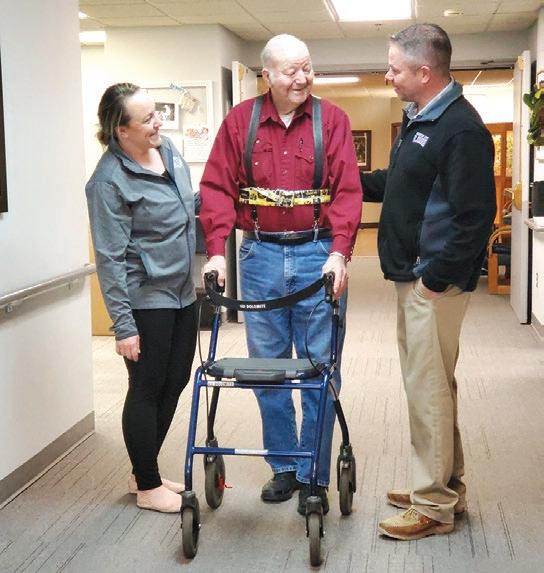



20 OUR HOMETOWN | AUGUST 2023 515-570-8715 We Install Vinyl Windows! CALL 40 plus yearsexperience LOCAL TO W.C. AREA WITH Classic Siding & Windows (INC.) 3242 Ubben Ave, Ellsworth, IA (515) 836-4400 Call us today for a tour: 515-832-2727 2401 Des Moines St. Webster City, IA www.crestviewnrc.com Skilled Care, Rehabilitation, Secured Memory Care, Independent Apartments FRESH LOOKS & LASTING IMPRESSIONS Vintage • Unique Home Decor • Clothing • Scarves • Jewelry Expires 9/27/23 20% Off Any one regular priced item excludes antiques and special orders COUPON CLEARANCE CHECK OUT OUR GARAGE! BARGAINS GALORE! 1423 Superior • Webster City (515-832-1457) Hours: Thursday-Friday 10am - 5pm Saturday 10am - 4pm www.heartnhomewebstercity.com Hamilton County’s Premier In-Home Care Provider 515.832.4442 LifeandHealthCare.com Submit your pet photos to tanderson@freemanjournal.net Please include pet’s & owner’s name
PeT pix


AUGUST 2023 | OUR HOMETOWN 21


22 OUR HOMETOWN | AUGUST 2023
Parting SHOT

AUGUST 2023 | OUR HOMETOWN 23
The Pain Management Services team uses a multi-faceted approach to treat patients with chronic pain. Treatment is provided on an outpatient basis by CRNAs certified in nonsurgical pain management.
























 By DAVID BORER
By DAVID BORER







 The vineyard at Backcountry Winery & Brewery at the conclusion of the Hamilton County Farm Crawl.
The vineyard at Backcountry Winery & Brewery at the conclusion of the Hamilton County Farm Crawl.










































